
- •Features
- •Pin Configurations
- •Overview
- •Block Diagram
- •Pin Descriptions
- •Port A (PA7..PA0)
- •Port B (PB7..PB0)
- •Port C (PC7..PC0)
- •Port D (PD7..PD0)
- •Port E (PE7..PE0)
- •Port F (PF7..PF0)
- •Port G (PG4..PG0)
- •RESET
- •XTAL1
- •XTAL2
- •AVCC
- •AREF
- •AVR CPU Core
- •Introduction
- •Architectural Overview
- •Status Register
- •Stack Pointer
- •Interrupt Response Time
- •SRAM Data Memory
- •Data Memory Access Times
- •EEPROM Data Memory
- •EEPROM Read/Write Access
- •I/O Memory
- •Overview
- •ATmega103 Compatibility
- •Address Latch Requirements
- •Pull-up and Bus-keeper
- •Timing
- •XMEM Register Description
- •Using all Locations of External Memory Smaller than 64 KB
- •Using all 64KB Locations of External Memory
- •Clock Systems and their Distribution
- •Clock Sources
- •Default Clock Source
- •Crystal Oscillator
- •External RC Oscillator
- •External Clock
- •Timer/Counter Oscillator
- •Idle Mode
- •Power-down Mode
- •Power-save Mode
- •Standby Mode
- •Extended Standby Mode
- •Analog to Digital Converter
- •Analog Comparator
- •Brown-out Detector
- •Internal Voltage Reference
- •Watchdog Timer
- •Port Pins
- •Resetting the AVR
- •Reset Sources
- •Power-on Reset
- •External Reset
- •Brown-out Detection
- •Watchdog Reset
- •Watchdog Timer
- •Timed Sequences for Changing the Configuration of the Watchdog Timer
- •Safety Level 0
- •Safety Level 1
- •Safety Level 2
- •Interrupts
- •I/O Ports
- •Introduction
- •Configuring the Pin
- •Reading the Pin Value
- •Unconnected pins
- •Alternate Port Functions
- •Alternate Functions of Port A
- •Alternate Functions of Port B
- •Alternate Functions of Port C
- •Alternate Functions of Port D
- •Alternate Functions of Port E
- •Alternate Functions of Port F
- •Alternate Functions of Port G
- •Register Description for I/O Ports
- •External Interrupts
- •8-bit Timer/Counter0 with PWM and Asynchronous Operation
- •Overview
- •Registers
- •Definitions
- •Counter Unit
- •Output Compare Unit
- •Force Output Compare
- •Modes of Operation
- •Normal Mode
- •Fast PWM Mode
- •Phase Correct PWM Mode
- •Timer/Counter Prescaler
- •16-bit Timer/Counter (Timer/Counter1 and Timer/Counter3)
- •Overview
- •Registers
- •Definitions
- •Compatibility
- •Counter Unit
- •Input Capture Unit
- •Input Capture Pin Source
- •Noise Canceler
- •Using the Input Capture Unit
- •Output Compare Units
- •Force Output Compare
- •Modes of Operation
- •Normal Mode
- •Fast PWM Mode
- •Phase Correct PWM Mode
- •Internal Clock Source
- •Prescaler Reset
- •External Clock Source
- •8-bit Timer/Counter2 with PWM
- •Overview
- •Registers
- •Definitions
- •Counter Unit
- •Output Compare Unit
- •Force Output Compare
- •Modes of Operation
- •Normal Mode
- •Fast PWM Mode
- •Phase Correct PWM Mode
- •Overview
- •Description
- •Timing Example
- •SS Pin Functionality
- •Slave Mode
- •Master Mode
- •Data Modes
- •USART
- •Dual USART
- •Overview
- •Clock Generation
- •External Clock
- •Synchronous Clock Operation
- •Frame Formats
- •Parity Bit Calculation
- •USART Initialization
- •Sending Frames with 5 to 8 Data Bit
- •Sending Frames with 9 Data Bit
- •Parity Generator
- •Disabling the Transmitter
- •Receiving Frames with 5 to 8 Data Bits
- •Receiving Frames with 9 Data Bits
- •Receiver Error Flags
- •Parity Checker
- •Disabling the Receiver
- •Flushing the Receive Buffer
- •Asynchronous Data Recovery
- •Using MPCM
- •Two-wire Serial Interface
- •Features
- •TWI Terminology
- •Electrical Interconnection
- •Transferring Bits
- •START and STOP Conditions
- •Address Packet Format
- •Data Packet Format
- •Overview of the TWI Module
- •Scl and SDA Pins
- •Bit Rate Generator Unit
- •Bus Interface Unit
- •Address Match Unit
- •Control Unit
- •TWI Register Description
- •Using the TWI
- •Transmission Modes
- •Master Transmitter Mode
- •Master Receiver Mode
- •Slave Receiver Mode
- •Slave Transmitter Mode
- •Miscellaneous States
- •Analog Comparator
- •Analog to Digital Converter
- •Features
- •Operation
- •Starting a Conversion
- •Differential Gain Channels
- •Changing Channel or Reference Selection
- •ADC Input Channels
- •ADC Voltage Reference
- •ADC Noise Canceler
- •Analog Input Circuitry
- •ADC Accuracy Definitions
- •ADC Conversion Result
- •ADLAR = 0:
- •ADLAR = 1:
- •Features
- •Overview
- •TAP Controller
- •PRIVATE0; $8
- •PRIVATE1; $9
- •PRIVATE2; $A
- •PRIVATE3; $B
- •Bibliography
- •Features
- •System Overview
- •Data Registers
- •Bypass Register
- •Device Identification Register
- •Version
- •Part Number
- •Manufacturer ID
- •Reset Register
- •Boundary-scan Chain
- •EXTEST; $0
- •IDCODE; $1
- •SAMPLE_PRELOAD; $2
- •AVR_RESET; $C
- •BYPASS; $F
- •Boundary-scan Chain
- •Scanning the Digital Port Pins
- •Scanning the RESET Pin
- •Scanning the Clock Pins
- •Scanning the ADC
- •Boot Loader Features
- •Application Section
- •Boot Loader Lock Bits
- •Performing a Page Write
- •Using the SPM Interrupt
- •Setting the Boot Loader Lock Bits by SPM
- •Reading the Fuse and Lock Bits from Software
- •Preventing Flash Corruption
- •Simple Assembly Code Example for a Boot Loader
- •Fuse Bits
- •Latching of Fuses
- •Signature Bytes
- •Calibration Byte
- •Signal Names
- •Parallel Programming
- •Enter Programming Mode
- •Chip Erase
- •Programming the Flash
- •Programming the EEPROM
- •Reading the Flash
- •Reading the EEPROM
- •Programming the Lock Bits
- •Reading the Signature Bytes
- •Reading the Calibration Byte
- •Serial Downloading
- •Data Polling Flash
- •Data Polling EEPROM
- •AVR_RESET ($C)
- •PROG_ENABLE ($4)
- •PROG_COMMANDS ($5)
- •PROG_PAGELOAD ($6)
- •PROG_PAGEREAD ($7)
- •Data Registers
- •Reset Register
- •Programming Enable Register
- •Programming Command Register
- •Virtual Flash Page Read Register
- •Programming Algorithm
- •Entering Programming Mode
- •Leaving Programming Mode
- •Performing Chip Erase
- •Programming the Flash
- •Reading the Flash
- •Programming the EEPROM
- •Reading the EEPROM
- •Programming the Fuses
- •Programming the Lock Bits
- •Reading the Signature Bytes
- •Reading the Calibration Byte
- •Electrical Characteristics
- •Absolute Maximum Ratings*
- •DC Characteristics
- •External Clock Drive Waveforms
- •External Clock Drive
- •Two-wire Serial Interface Characteristics
- •ADC Characteristics
- •External Data Memory Timing
- •Active Supply Current
- •Idle Supply Current
- •Power-down Supply Current
- •Power-save Supply Current
- •Standby Supply Current
- •Pin Pull-up
- •Pin Driver Strength
- •Internal Oscillator Speed
- •Current Consumption in Reset and Reset Pulse width
- •Register Summary
- •Instruction Set Summary
- •Ordering Information
- •Packaging Information
- •Errata
- •ATmega128 Rev. I
- •ATmega128 Rev. H
- •ATmega128 Rev. G
- •ATmega128 Rev. F
- •Changes from Rev. 2467L-05/04 to Rev. 2467M-11/04
- •Changes from Rev. 2467K-03/04 to Rev. 2467L-05/04
- •Changes from Rev. 2467J-12/03 to Rev. 2467K-03/04
- •Changes from Rev. 2467I-09/03 to Rev. 2467J-12/03
- •Changes from Rev. 2467H-02/03 to Rev. 2467I-09/03
- •Changes from Rev. 2467G-09/02 to Rev. 2467H-02/03
- •Changes from Rev. 2467F-09/02 to Rev. 2467G-09/02
- •Changes from Rev. 2467E-04/02 to Rev. 2467F-09/02
- •Changes from Rev. 2467D-03/02 to Rev. 2467E-04/02
- •Changes from Rev. 2467C-02/02 to Rev. 2467D-03/02
- •Changes from Rev. 2467B-09/01 to Rev. 2467C-02/02
- •Table of Contents
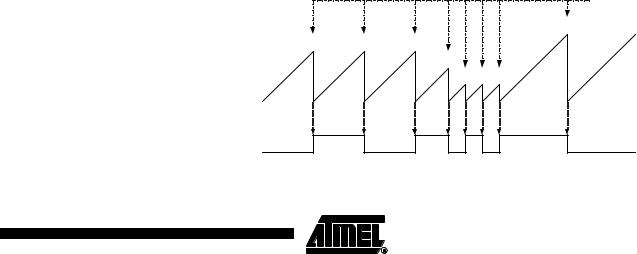
|
|
|
|
|
|
|
|
|
|
|
|
|
|
|
|
|
|
|
ATmega128 |
||
|
|
|
|
|
|
|
|
|
|
|
|
|
|
|
|
|
|
|
|||
|
|
|
|
|
|
|
|
|
|
|
|
|
|
|
|
|
|
|
|||
|
|
A change of the COM21:0 bits state will have effect at the first compare match after the |
|||||||||||||||||||
|
|
||||||||||||||||||||
|
|
bits are written. For non-PWM modes, the action can be forced to have immediate effect |
|||||||||||||||||||
|
|
by using the FOC2 strobe bits. |
|||||||||||||||||||
|
Modes of Operation |
The mode of operation, i.e., the behavior of the Timer/Counter and the Output Compare |
|||||||||||||||||||
|
|
pins, is defined by the combination of the Waveform Generation mode (WGM21:0) and |
|||||||||||||||||||
|
|
Compare Output mode (COM21:0) bits. The Compare Output mode bits do not affect |
|||||||||||||||||||
|
|
the counting sequence, while the Waveform Generation mode bits do. The COM21:0 |
|||||||||||||||||||
|
|
bits control whether the PWM output generated should be inverted or not (inverted or |
|||||||||||||||||||
|
|
non-inverted PWM). For non-PWM modes the COM21:0 bits control whether the output |
|||||||||||||||||||
|
|
should be set, cleared, or toggled at a compare match (see “Compare Match Output |
|||||||||||||||||||
|
|
Unit” on page 148). |
|||||||||||||||||||
|
|
For detailed timing information refer to Figure 68, Figure 69, Figure 70, and Figure 71 in |
|||||||||||||||||||
|
|
“Timer/Counter Timing Diagrams” on page 154. |
|||||||||||||||||||
|
Normal Mode |
The simplest mode of operation is the normal mode (WGM21:0 = 0). In this mode the |
|||||||||||||||||||
|
|
counting direction is always up (incrementing), and no counter clear is performed. The |
|||||||||||||||||||
|
|
counter simply overruns when it passes its maximum 8-bit value (TOP = 0xFF) and then |
|||||||||||||||||||
|
|
restarts from the bottom (0x00). In normal operation the Timer/Counter overflow flag |
|||||||||||||||||||
|
|
(TOV2) will be set in the same timer clock cycle as the TCNT2 becomes zero. The TOV2 |
|||||||||||||||||||
|
|
flag in this case behaves like a ninth bit, except that it is only set, not cleared. However, |
|||||||||||||||||||
|
|
combined with the timer overflow interrupt that automatically clears the TOV2 flag, the |
|||||||||||||||||||
|
|
timer resolution can be increased by software. There are no special cases to consider in |
|||||||||||||||||||
|
|
the normal mode, a new counter value can be written anytime. |
|||||||||||||||||||
|
|
The output compare unit can be used to generate interrupts at some given time. Using |
|||||||||||||||||||
|
|
the output compare to generate waveforms in normal mode is not recommended, since |
|||||||||||||||||||
|
|
this will occupy too much of the CPU time. |
|||||||||||||||||||
|
Clear Timer on Compare |
In Clear Timer on Compare or CTC mode (WGM21:0 = 2), the OCR2 Register is used to |
|||||||||||||||||||
|
Match (CTC) Mode |
manipulate the counter resolution. In CTC mode the counter is cleared to zero when the |
|||||||||||||||||||
|
|
counter value (TCNT2) matches the OCR2. The OCR2 defines the top value for the |
|||||||||||||||||||
|
|
counter, hence also its resolution. This mode allows greater control of the compare |
|||||||||||||||||||
|
|
match output frequency. It also simplifies the operation of counting external events. |
|||||||||||||||||||
|
|
The timing diagram for the CTC mode is shown in Figure 65. The counter value |
|||||||||||||||||||
|
|
(TCNT2) increases until a compare match occurs between TCNT2 and OCR2 and then |
|||||||||||||||||||
|
|
counter (TCNT2) is cleared. |
|||||||||||||||||||
|
|
Figure 65. CTC Mode, Timing Diagram |
|||||||||||||||||||
|
|
|
|
|
|
|
|
|
|
|
|
|
|
|
|
|
|
|
|
|
|
|
|
|
|
|
|
|
|
|
|
|
|
|
|
|
|
|
|
|
|
OCn Interrupt Flag Set |
|
|
|
|
|
|
|
|
|
|
|
|
|
|
|
|
|
|
|
|
|
|
|
|
|
|
|
|
|
|
|
|
|
|
|
|
|
|
|
|
|
|
|
|
|
|
|
|
|
|
|
|
|
|
|
|
|
|
|
|
|
|
|
|
|
|
|
|
|
|
|
|
|
|
|
|
|
|
|
|
|
|
|
|
|
|
|
|
|
|
|
|
|
|
|
|
|
|
|
|
|
|
|
|
|
|
|
|
|
|
|
TCNTn
OCn
(COMn1:0 = 1)
(Toggle)
Period  1
1 
 2
2 
 3
3 
 4
4 

149
2467M–AVR–11/04

An interrupt can be generated each time the counter value reaches the TOP value by using the OCF2 flag. If the interrupt is enabled, the interrupt handler routine can be used for updating the TOP value. However, changing the TOP to a value close to BOTTOM when the counter is running with none or a low prescaler value must be done with care since the CTC mode does not have the double buffering feature. If the new value written to OCR2 is lower than the current value of TCNT2, the counter will miss the compare match. The counter will then have to count to its maximum value (0xFF) and wrap around starting at 0x00 before the compare match can occur.
For generating a waveform output in CTC mode, the OC2 output can be set to toggle its logical level on each compare match by setting the compare output mode bits to toggle mode (COM21:0 = 1). The OC2 value will not be visible on the port pin unless the data direction for the pin is set to output. The waveform generated will have a maximum fre-
quency of fOC2 = fclk_I/O/2 when OCR2 is set to zero (0x00). The waveform frequency is defined by the following equation:
|
fOCn = |
fclk_I/O |
|
2--------N---------(--1-----+-----OCRn----------------)- |
|
|
The N variable represents the prescale factor (1, 8, 64, 256, or 1024). |
|
|
As for the normal mode of operation, the TOV2 flag is set in the same timer clock cycle |
|
|
that the counter counts from MAX to 0x00. |
|
Fast PWM Mode |
The fast Pulse Width Modulation or fast PWM mode (WGM21:0 = 3) provides a high fre- |
|
|
quency PWM waveform generation option. The fast PWM differs from the other PWM |
|
|
option by its single-slope operation. The counter counts from BOTTOM to MAX then |
|
|
restarts from BOTTOM. In non-inverting Compare Output mode, the output compare |
|
(OC2) is cleared on the compare match between TCNT2 and OCR2, and set at BOTTOM. In inverting Compare Output mode, the output is set on compare match and cleared at BOTTOM. Due to the single-slope operation, the operating frequency of the fast PWM mode can be twice as high as the phase correct PWM mode that use dualslope operation. This high frequency makes the fast PWM mode well suited for power regulation, rectification, and DAC applications. High frequency allows physically small sized external components (coils, capacitors), and therefore reduces total system cost.
In fast PWM mode, the counter is incremented until the counter value matches the MAX value. The counter is then cleared at the following timer clock cycle. The timing diagram for the fast PWM mode is shown in Figure 66. The TCNT2 value is in the timing diagram shown as a histogram for illustrating the single-slope operation. The diagram includes non-inverted and inverted PWM outputs. The small horizontal line marks on the TCNT2 slopes represent compare matches between OCR2 and TCNT2.
150 ATmega128
2467M–AVR–11/04
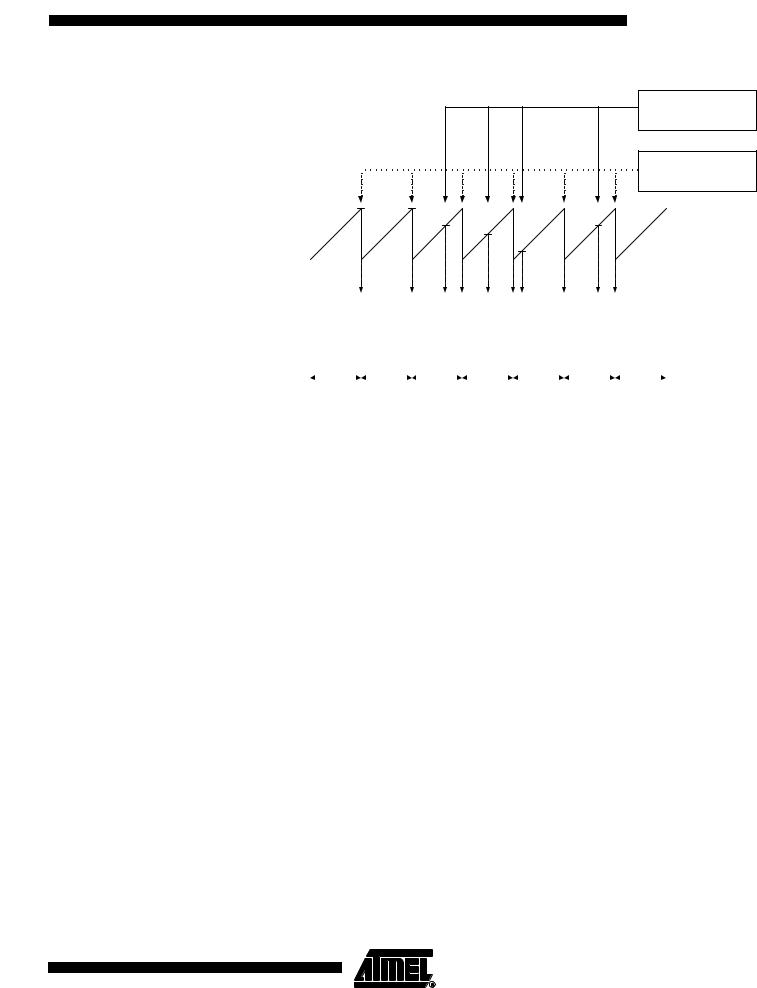
ATmega128
Figure 66. Fast PWM Mode, Timing Diagram
OCRn Interrupt Flag Set
OCRn Update





















































 and
and
TOVn Interrupt Flag Set
TCNTn
OCn |
|
|
|
|
|
|
|
|
|
|
|
|
|
|
|
|
|
|
|
|
|
|
|
|
|
|
|
|
|
|
|
|
|
|
|
|
|
|
|
|
|
|
|
|
|
|
|
|
|
|
|
|
|
|
|
|
|
|
|
|
|
|
|
|
|
|
|
|
|
|
|
(COMn1:0 = 2) |
|||
|
|
|
|
|
|
|
|
|
|
|
|
|
|
|
|
|
|
|
|
|
|
|
|
|
|
|
|
|
|
|
|
|
|
|
|
|
|
OCn |
|
|
|
|
|
|
|
|
|
|
|
|
|
|
|
|
|
|
|
|
|
|
|
|
|
|
|
|
|
|
|
|
|
|
(COMn1:0 = 3) |
||
Period |
|
|
|
|
|
|
|
|
|
|
|
|
|
|
|
|
|
|
|
|
|
|
|
|
|
|
|
|
|
|
|
|
|
|
|
|
|
|
|
|
|
|
|
|
|
|
|
|
|
|
|
|
|
|
|
|
|
|
|
|
|
|
|
|
|
|
|
|
|
|
|
|
|
||
|
|
1 |
|
|
|
|
2 |
|
|
|
|
3 |
|
|
|
|
4 |
|
|
|
5 |
|
|
|
6 |
|
|
|
|
7 |
|
|
|
|
|||
|
|
|
|
|
|
|
|
|
|
|
|
|
|
|
|
||||||||||||||||||||||
|
|
|
|
|
|
|
|
|
|
|
|
|
|
|
|
|
|
|
|
|
|
|
|
|
|
|
|
|
|
|
|
|
|
|
|
|
|
The Timer/Counter overflow flag (TOV2) is set each time the counter reaches Max If the interrupt is enabled, the interrupt handler routine can be used for updating the compare value.
In fast PWM mode, the compare unit allows generation of PWM waveforms on the OC2 pin. Setting the COM21:0 bits to 2 will produce a non-inverted PWM and an inverted PWM output can be generated by setting the COM21:0 to 3 (see Table 66 on page 157). The actual OC2 value will only be visible on the port pin if the data direction for the port pin is set as output. The PWM waveform is generated by setting (or clearing) the OC2 Register at the compare match between OCR2 and TCNT2, and clearing (or setting) the OC2 Register at the timer clock cycle the counter is cleared (changes from MAX to BOTTOM).
The PWM frequency for the output can be calculated by the following equation:
f |
|
fclk_I/O |
OCnPWM |
= ----------------- |
|
|
N 256 |
The N variable represents the prescale factor (1, 8, 64, 256, or 1024).
The extreme values for the OCR2 Register represents special cases when generating a PWM waveform output in the fast PWM mode. If the OCR2 is set equal to BOTTOM, the output will be a narrow spike for each MAX+1 timer clock cycle. Setting the OCR2 equal to MAX will result in a constantly high or low output (depending on the polarity of the output set by the COM21:0 bits.)
A frequency (with 50% duty cycle) waveform output in fast PWM mode can be achieved by setting OC2 to toggle its logical level on each compare match (COM21:0 = 1). The waveform generated will have a maximum frequency of fOC2 = fclk_I/O/2 when OCR2 is set to zero. This feature is similar to the OC2 toggle in CTC mode, except the double buffer feature of the output compare unit is enabled in the fast PWM mode.
151
2467M–AVR–11/04
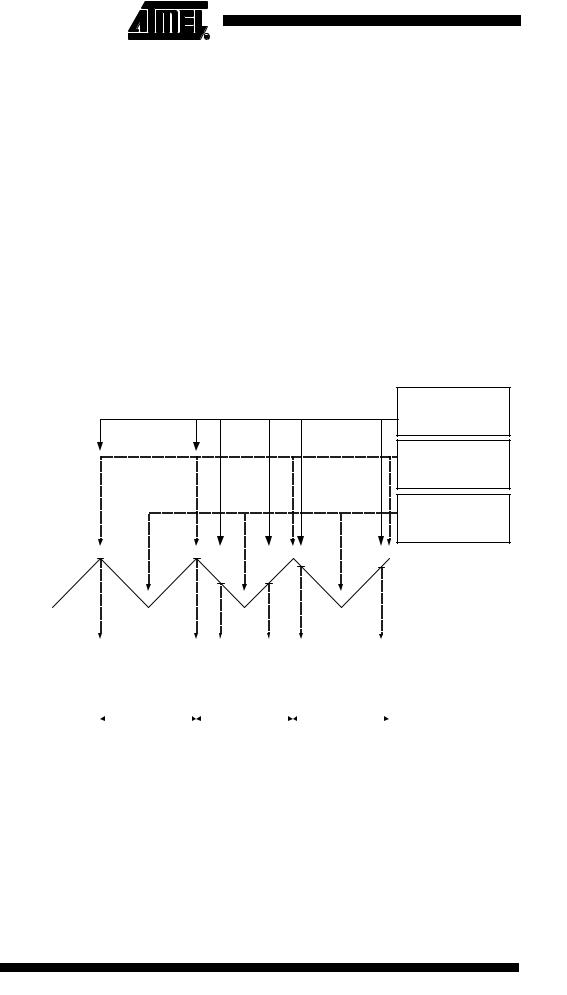
Phase Correct PWM Mode The phase correct PWM mode (WGM21:0 = 1) provides a high resolution phase correct PWM waveform generation option. The phase correct PWM mode is based on a dualslope operation. The counter counts repeatedly from BOTTOM to MAX and then from MAX to BOTTOM. In non-inverting Compare Output mode, the output compare (OC2) is cleared on the compare match between TCNT2 and OCR2 while counting up, and set on the compare match while downcounting. In inverting Output Compare mode, the operation is inverted. The dual-slope operation has lower maximum operation frequency than single slope operation. However, due to the symmetric feature of the dual-slope PWM modes, these modes are preferred for motor control applications.
The PWM resolution for the phase correct PWM mode is fixed to 8 bits. In phase correct PWM mode the counter is incremented until the counter value matches Max When the counter reaches MAX, it changes the count direction. The TCNT2 value will be equal to MAX for one timer clock cycle. The timing diagram for the phase correct PWM mode is shown on Figure 67. The TCNT2 value is in the timing diagram shown as a histogram for illustrating the dual-slope operation. The diagram includes non-inverted and inverted PWM outputs. The small horizontal line marks on the TCNT2 slopes represent compare matches between OCR2 and TCNT2.
Figure 67. Phase Correct PWM Mode, Timing Diagram
OCn Interrupt Flag Set
OCRn Update
TOVn Interrupt Flag Set
TCNTn
OCn |
|
|
|
|
|
|
|
|
|
|
|
|
|
|
|
|
|
|
|
|
(COMn1:0 = 2) |
|
|
|
|
|
|
|
|
|
|
|
|
|
|
|
|
|
|
|
|
|
|
|
|
|
|
|
|
|
|
|
|
|
|
|
|
|
|
|
|
|
|
|
|
|
|
|
OCn |
|
|
|
|
|
|
|
|
|
|
|
|
|
|
|
|
|
|
|
(COMn1:0 = 3) |
||
|
|
|
|
|
|
|
|
|
|
|
|
|
|
|
|
|
|
|
||||
|
|
|
|
|
|
|
|
|
|
|
|
|
|
|
|
|
|
|
|
|
|
|
Period |
|
|
|
|
|
|
|
|
|
|
|
|
|
|
|
|
|
|
|
|
||
|
|
|
|
|
|
|
|
|
|
|
|
|
|
|
|
|
|
|
|
|||
|
|
1 |
|
|
|
|
|
2 |
|
|
|
|
|
|
3 |
|
|
|
|
|||
|
|
|
|
|
|
|
|
|
|
|||||||||||||
|
|
|
|
|
|
|
|
|
|
|
|
|
|
|
|
|
|
|
|
|
|
|
The Timer/Counter Overflow Flag (TOV2) is set each time the counter reaches BOTTOM. The interrupt flag can be used to generate an interrupt each time the counter reaches the BOTTOM value.
In phase correct PWM mode, the compare unit allows generation of PWM waveforms on the OC2 pin. Setting the COM21:0 bits to 2 will produce a non-inverted PWM. An inverted PWM output can be generated by setting the COM21:0 to 3 (see Table 67 on page 157). The actual OC2 value will only be visible on the port pin if the data direction for the port pin is set as output. The PWM waveform is generated by clearing (or setting) the OC2 Register at the compare match between OCR2 and TCNT2 when the counter increments, and setting (or clearing) the OC2 Register at compare match between
152 ATmega128
2467M–AVR–11/04

 ATmega128
ATmega128
OCR2 and TCNT2 when the counter decrements. The PWM frequency for the output when using phase correct PWM can be calculated by the following equation:
f |
|
fclk_I/O |
OCnPCPWM |
= ----------------- |
|
|
N 510 |
The N variable represents the prescale factor (1, 8, 64, 256, or 1024).
The extreme values for the OCR2 Register represent special cases when generating a PWM waveform output in the phase correct PWM mode. If the OCR2 is set equal to BOTTOM, the output will be continuously low and if set equal to MAX the output will be continuously high for non-inverted PWM mode. For inverted PWM the output will have the opposite logic values.
At the very start of Period 2 in Figure 67 OCn has a transition from high to low even though there is no Compare Match. The point of this transition is to guarantee symmetry around BOTTOM. There are two cases that give a transition without a Compare Match:
•OCR2A changes its value from MAX, like in Figure 67. When the OCR2A value is MAX the OCn pin value is the same as the result of a down-counting Compare Match. To ensure symmetry around BOTTOM the OCn value at MAX must correspond to the result of an up-counting Compare Match.
•The timer starts counting from a value higher than the one in OCR2A, and for that reason misses the Compare Match and hence the OCn change that would have happened on the way up.
153
2467M–AVR–11/04
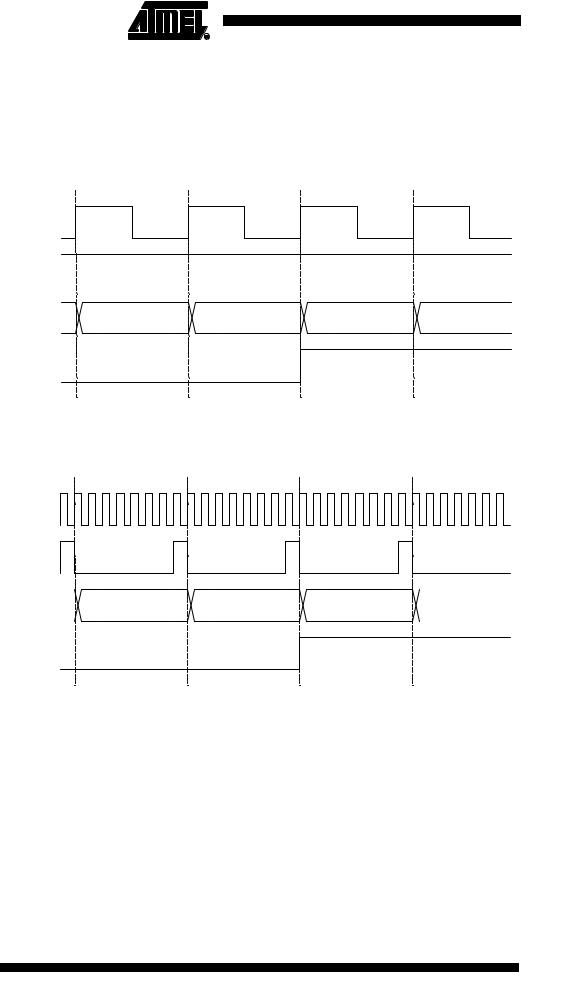
Timer/Counter Timing
Diagrams
The Timer/Counter is a synchronous design and the timer clock (clkT2) is therefore shown as a clock enable signal in the following figures. The figures include information on when interrupt flags are set. Figure 68 contains timing data for basic Timer/Counter operation. The figure shows the count sequence close to the MAX value in all modes other than phase correct PWM mode.
Figure 68. Timer/Counter Timing Diagram, no Prescaling
clkI/O
clkTn
(clkI/O/1)
TCNTn |
MAX - 1 |
|
MAX |
|
BOTTOM |
|
BOTTOM + 1 |
|
|
|
|
|
|
|
|
TOVn
Figure 69 shows the same timing data, but with the prescaler enabled.
Figure 69. Timer/Counter Timing Diagram, with Prescaler (fclk_I/O/8)
clkI/O
clkTn
(clkI/O/8)
TCNTn |
|
|
MAX - 1 |
|
MAX |
|
BOTTOM |
|
|
BOTTOM + 1 |
|
|
|
|
|
|
|
|
|
|
|
TOVn
Figure 70 shows the setting of OCF2 in all modes except CTC mode.
154 ATmega128
2467M–AVR–11/04
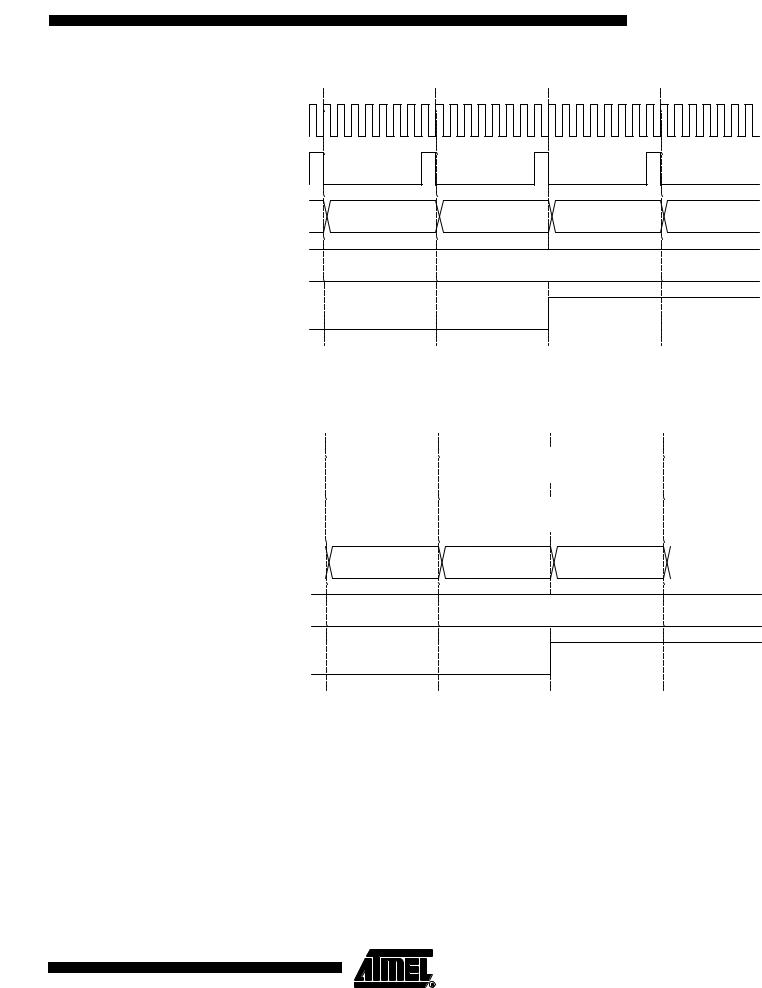
ATmega128
Figure 70. Timer/Counter Timing Diagram, Setting of OCF2, with Prescaler (fclk_I/O/8)
clkI/O |
|
|
|
|
clkTn |
|
|
|
|
(clkI/O/8) |
|
|
|
|
TCNTn |
OCRn - 1 |
OCRn |
OCRn + 1 |
OCRn + 2 |
OCRn |
|
OCRn Value |
|
|
OCFn
Figure 71 shows the setting of OCF2 and the clearing of TCNT2 in CTC mode.
Figure 71. Timer/Counter Timing Diagram, Clear Timer on Compare Match Mode, with
Prescaler (fclk_I/O/8)
clkI/O |
|
|
|
|
|
|
|
|
|
|
|
|
|
|
|
|
|
|
|
|
|
|
|
|
|
|
|
|
|
|
|
|
|
|
|
|
|
|
|
|
|
|
|
|
|
|
|
|
|
|
|
|
|
|
|
|
|
|
|
|
|
|
|
|
clkTn |
|
|
|
|
|
|
|
|
|
|
|
|
|
|
|
|
|
|
|
|
|
|
|
|
|
|
|
|
|
|
|
|
|
|
|
|
|
|
|
|
|
|
|
|
|
|
|
|
|
|
|
|
|
|
|
|
|
|
|
|
|
|
|
|
|
|
|
|
|
|
|
|
|
|
|
|
|
|
|
|
|
|
|
|
|
|
|
|
|
|
|
|
|
|
|
|
|
|
|
|
|
|
|
|
|
|
|
|
|
|
|
|
|
|
|
|
|
|
|
|
|
|
|
|
|
|
|
|
|
(clkI/O/8) |
|
|
|
|
|
|
|
|
|
|
|
|
|
|
|
|
|
|
|
|
|
|
|
|
|
|
|
|
|
|
|
|
|
|
|
|
|
|
|
|
|
|
|
|
|
|
|
|
|
|
|
|
|
|
|
|
|
|
|
|
|
|
|
|
TCNTn |
|
|
|
|
|
|
|
|
|
|
|
|
|
|
|
|
|
|
|
|
|
|
|
|
|
|
|
|
|
|
|
|
|
|
|
|
|
|
|
|
|
|
|
|
|
|
|
|
|
|
|
|
|
|
|
|
|
|
|
|
|
|
|
|
|
|
|
|
|
|
|
|
TOP - 1 |
|
|
|
|
|
|
|
|
|
|
TOP |
|
|
|
|
|
|
|
|
|
|
BOTTOM |
|
|
|
|
|
|
BOTTOM + 1 |
|||||||||||||||||||||||||||
(CTC) |
|
|
|
|
|
|
|
|
|
|
|
|
|
|
|
|
|
|
|
|
|
|
|
|
|
|
|
|
|
|
|
|
|
|
||||||||||||||||||||||||||||||
|
|
|
|
|
|
|
|
|
|
|
|
|
|
|
|
|
|
|
|
|
|
|
|
|
|
|
|
|
|
|
|
|
|
|
|
|
|
|
|
|
|
|
|
|
|
|
|
|
|
|
|
|
|
|
|
|
|
|
|
|
|
|
|
|
OCRn |
|
|
|
|
|
|
|
|
|
|
|
|
|
|
|
|
|
|
|
|
|
|
|
|
|
|
|
|
|
|
|
|
|
|
|
|
|
|
|
|
|
|
|
|
|
|
|
|
|
|
|
|
|
|
|
|
|
|
|
|
|
|
|
|
|
|
|
|
|
|
|
|
|
|
|
|
|
|
|
|
|
|
|
|
|
|
|
|
|
|
|
|
|
|
|
TOP |
|
|
|
|
|
|
|
|
|
|
|
|
|
|
|
|
|
||||||||||||||||
|
|
|
|
|
|
|
|
|
|
|
|
|
|
|
|
|
|
|
|
|
|
|
|
|
|
|
|
|
|
|
|
|
|
|
|
|
|
|
|
|
|
|
|
|
|
|
|
|
|
|
|
|
|
|
|
|
|
|
|
|
|
|
|
|
OCFn
155
2467M–AVR–11/04

8-bit Timer/Counter
Register Description
Timer/Counter Control
Register – TCCR2
|
|
|
|
|
|
|
|
|
|
|
|
|
|
|
|
|
|
|
|
|
|
|
|
|
|
Bit |
7 |
6 |
|
5 |
4 |
3 |
2 |
1 |
0 |
|
||
|
|
|
|
|
|
|
|
|
|
|
||
|
FOC2 |
WGM20 |
|
COM21 |
COM20 |
WGM21 |
CS22 |
CS21 |
CS20 |
TCCR2 |
||
|
|
|
|
|
|
|
|
|
|
|
|
|
Read/Write |
W |
R/W |
|
R/W |
R/W |
R/W |
R/W |
R/W |
R/W |
|
||
Initial Value |
0 |
0 |
|
0 |
0 |
0 |
0 |
0 |
0 |
|
||
• Bit 7 – FOC2: Force Output Compare
The FOC2 bit is only active when the WGM20 bit specifies a non-PWM mode. However, for ensuring compatibility with future devices, this bit must be set to zero when TCCR2 is written when operating in PWM mode. When writing a logical one to the FOC2 bit, an immediate compare match is forced on the waveform generation unit. The OC2 output is changed according to its COM21:0 bits setting. Note that the FOC2 bit is implemented as a strobe. Therefore it is the value present in the COM21:0 bits that determines the effect of the forced compare.
A FOC2 strobe will not generate any interrupt, nor will it clear the Timer in CTC mode using OCR2 as TOP.
The FOC2 bit is always read as zero.
• Bit 6, 3 – WGM21:0: Waveform Generation Mode
These bits control the counting sequence of the counter, the source for the maximum (TOP) counter value, and what type of waveform generation to be used. Modes of operation supported by the Timer/Counter unit are: Normal mode, Clear Timer on Compare match (CTC) mode, and two types of Pulse Width Modulation (PWM) modes. See Table 64 and “Modes of Operation” on page 149.
Table 64. Waveform Generation Mode Bit Description
|
WGM21 |
WGM20 |
Timer/Counter Mode |
|
Update of |
TOV2 Flag |
Mode |
(CTC2) |
(PWM2) |
of Operation |
TOP |
OCR2 at |
Set on |
|
|
|
|
|
|
|
0 |
0 |
0 |
Normal |
0xFF |
Immediate |
MAX |
|
|
|
|
|
|
|
1 |
0 |
1 |
PWM, Phase Correct |
0xFF |
TOP |
BOTTOM |
|
|
|
|
|
|
|
2 |
1 |
0 |
CTC |
OCR2 |
Immediate |
MAX |
|
|
|
|
|
|
|
3 |
1 |
1 |
Fast PWM |
0xFF |
TOP |
MAX |
|
|
|
|
|
|
|
Note: The CTC2 and PWM2 bit definition names are now obsolete. Use the WGM21:0 definitions. However, the functionality and location of these bits are compatible with previous versions of the timer.
• Bit 5:4 – COM21:0: Compare Match Output Mode
These bits control the Output Compare Pin (OC2) behavior. If one or both of the COM21:0 bits are set, the OC2 output overrides the normal port functionality of the I/O pin it is connected to. However, note that the Data Direction Register (DDR) bit corresponding to the OC2 pin must be set in order to enable the output driver.
When OC2 is connected to the pin, the function of the COM21:0 bits depends on the WGM21:0 bit setting. Table 65 shows the COM21:0 bit functionality when the WGM21:0 bits are set to a normal or CTC mode (non-PWM).
156 ATmega128
2467M–AVR–11/04

|
|
|
|
|
ATmega128 |
|
|
|
|
|
|
|
|
|
|
|
|
|
|
Table 65. Compare Output Mode, Non-PWM Mode |
|||
|
|
||||
|
|
|
|
|
|
|
|
COM21 |
COM20 |
Description |
|
|
|
|
|
||
|
|
0 |
0 |
Normal port operation, OC2 disconnected. |
|
|
|
|
|
||
|
|
0 |
1 |
Toggle OC2 on compare match |
|
|
|
|
|
||
|
|
1 |
0 |
Clear OC2 on compare match |
|
|
|
|
|
||
|
|
1 |
1 |
Set OC2 on compare match |
|
|
|
|
|
|
|
Table 66 shows the COM21:0 bit functionality when the WGM21:0 bits are set to fast
PWM mode.
Table 66. Compare Output Mode, Fast PWM Mode(1)
COM21 |
COM20 |
Description |
|
|
|
0 |
0 |
Normal port operation, OC2 disconnected. |
|
|
|
0 |
1 |
Reserved |
|
|
|
1 |
0 |
Clear OC2 on compare match, set OC2 at TOP |
|
|
|
1 |
1 |
Set OC2 on compare match, clear OC2 at TOP |
|
|
|
Note: 1. A special case occurs when OCR2 equals TOP and COM21 is set. In this case, the compare match is ignored, but the set or clear is done at TOP. See “Fast PWM Mode” on page 150 for more details.
Table 67 shows the COM21:0 bit functionality when the WGM21:0 bits are set to phase correct PWM mode.
Table 67. Compare Output Mode, Phase Correct PWM Mode(1)
COM21 |
COM20 |
Description |
|
|
|
0 |
0 |
Normal port operation, OC2 disconnected. |
|
|
|
0 |
1 |
Reserved |
|
|
|
1 |
0 |
Clear OC2 on compare match when up-counting. Set OC2 on compare |
|
|
match when downcounting. |
|
|
|
1 |
1 |
Set OC2 on compare match when up-counting. Clear OC2 on compare |
|
|
match when downcounting. |
|
|
|
Note: 1. A special case occurs when OCR2 equals TOP and COM21 is set. In this case, the compare match is ignored, but the set or clear is done at TOP. See “Phase Correct PWM Mode” on page 152 for more details.
• Bit 2:0 – CS22:0: Clock Select
The three clock select bits select the clock source to be used by the Timer/Counter.
Table 68. Clock Select Bit Description
CS22 |
CS21 |
CS20 |
Description |
|
|
|
|
0 |
0 |
0 |
No clock source (Timer/Counter stopped) |
|
|
|
|
0 |
0 |
1 |
clkI/O/(No prescaling) |
0 |
1 |
0 |
clkI/O/8 (From prescaler) |
0 |
1 |
1 |
clkI/O/64 (From prescaler) |
1 |
0 |
0 |
clkI/O/256 (From prescaler) |
157
2467M–AVR–11/04

Timer/Counter Register –
TCNT2
Table 68. Clock Select Bit Description
CS22 |
CS21 |
CS20 |
Description |
|
|
|
|
1 |
0 |
1 |
clkI/O/1024 (From prescaler) |
1 |
1 |
0 |
External clock source on T2 pin. Clock on falling edge |
|
|
|
|
1 |
1 |
1 |
External clock source on T2 pin. Clock on rising edge |
|
|
|
|
If external pin modes are used for the Timer/Counter2, transitions on the T2 pin will clock the counter even if the pin is configured as an output. This feature allows software control of the counting.
Bit |
7 |
6 |
5 |
4 |
3 |
2 |
1 |
0 |
|
|
|
|
|
TCNT2[7:0] |
|
|
|
TCNT2 |
|
|
|
|
|
|
|
|
|
|
|
Read/Write |
R/W |
R/W |
R/W |
R/W |
R/W |
R/W |
R/W |
R/W |
|
Initial Value |
0 |
0 |
0 |
0 |
0 |
0 |
0 |
0 |
|
The Timer/Counter Register gives direct access, both for read and write operations, to the Timer/Counter unit 8-bit counter. Writing to the TCNT2 Register blocks (removes) the compare match on the following timer clock. Modifying the counter (TCNT2) while the counter is running, introduces a risk of missing a compare match between TCNT2 and the OCR2 Register.
Output Compare Register –
OCR2
Bit |
7 |
6 |
5 |
4 |
3 |
2 |
1 |
0 |
|
|
|
|
|
OCR2[7:0] |
|
|
|
OCR2 |
|
|
|
|
|
|
|
|
|
|
|
Read/Write |
R/W |
R/W |
R/W |
R/W |
R/W |
R/W |
R/W |
R/W |
|
Initial Value |
0 |
0 |
0 |
0 |
0 |
0 |
0 |
0 |
|
The Output Compare Register contains an 8-bit value that is continuously compared with the counter value (TCNT2). A match can be used to generate an output compare interrupt, or to generate a waveform output on the OC2 pin.
Timer/Counter Interrupt Mask
Register – TIMSK
Bit |
7 |
6 |
5 |
4 |
3 |
2 |
1 |
0 |
|
|
OCIE2 |
TOIE2 |
TICIE1 |
OCIE1A |
OCIE1B |
TOIE1 |
OCIE0 |
TOIE0 |
TIMSK |
Read/Write |
R/W |
R/W |
R/W |
R/W |
R/W |
R/W |
R/W |
R/W |
|
Initial Value |
0 |
0 |
0 |
0 |
0 |
0 |
0 |
0 |
|
• Bit 7 – OCIE2: Timer/Counter2 Output Compare Match Interrupt Enable
When the OCIE2 bit is written to one, and the I-bit in the Status Register is set (one), the Timer/Counter2 Compare Match interrupt is enabled. The corresponding interrupt is executed if a compare match in Timer/Counter2 occurs, i.e., when the OCF2 bit is set in the Timer/Counter Interrupt Flag Register – TIFR.
• Bit 6 – TOIE2: Timer/Counter2 Overflow Interrupt Enable
When the TOIE2 bit is written to one, and the I-bit in the Status Register is set (one), the Timer/Counter2 Overflow interrupt is enabled. The corresponding interrupt is executed if an overflow in Timer/Counter2 occurs, i.e., when the TOV2 bit is set in the Timer/Counter Interrupt Flag Register – TIFR.
Timer/Counter Interrupt Flag
Register – TIFR
Bit |
7 |
6 |
5 |
4 |
3 |
2 |
1 |
0 |
|
|
OCF2 |
TOV2 |
ICF1 |
OCF1A |
OCF1B |
TOV1 |
OCF0 |
TOV0 |
TIFR |
|
|
|
|
|
|
|
|
|
|
158 ATmega128
2467M–AVR–11/04

ATmega128
Read/Write |
R/W |
R/W |
R/W |
R/W |
R/W |
R/W |
R/W |
R/W |
Initial Value |
0 |
0 |
0 |
0 |
0 |
0 |
0 |
0 |
• Bit 7 – OCF2: Output Compare Flag 2
The OCF2 bit is set (one) when a compare match occurs between the Timer/Counter2 and the data in OCR2 – Output Compare Register2. OCF2 is cleared by hardware when executing the corresponding interrupt handling vector. Alternatively, OCF2 is cleared by writing a logic one to the flag. When the I-bit in SREG, OCIE2 (Timer/Counter2 Compare Match Interrupt Enable), and OCF2 are set (one), the Timer/Counter2 Compare Match Interrupt is executed.
• Bit 6 – TOV2: Timer/Counter2 Overflow Flag
The bit TOV2 is set (one) when an overflow occurs in Timer/Counter2. TOV2 is cleared by hardware when executing the corresponding interrupt handling vector. Alternatively, TOV2 is cleared by writing a logic one to the flag. When the SREG I-bit, TOIE2 (Timer/Counter2 Overflow Interrupt Enable), and TOV2 are set (one), the Timer/Counter2 Overflow interrupt is executed. In PWM mode, this bit is set when Timer/Counter2 changes counting direction at $00.
159
2467M–AVR–11/04
